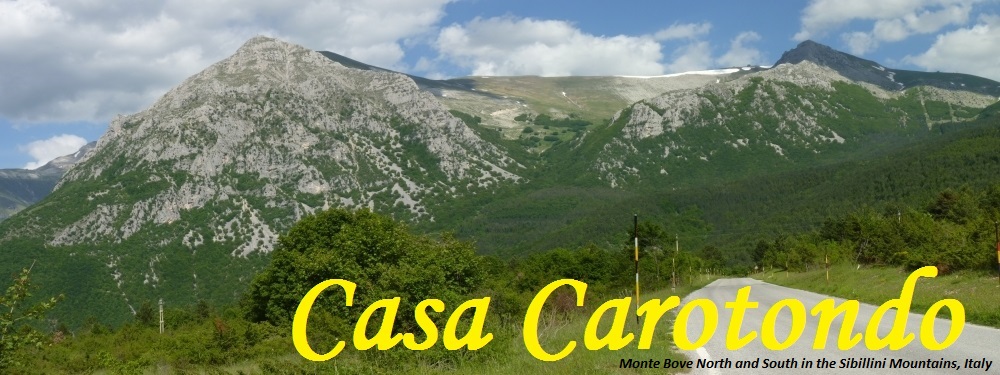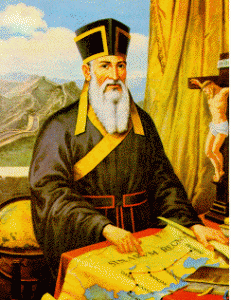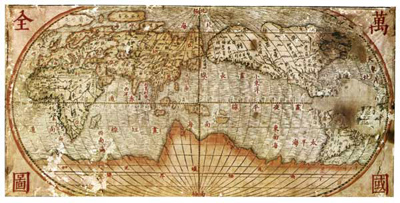Ricci studied in Macerata (then part of the Papal States) and Rome before becoming a Jesuit. After several years in Rome he asked to be sent to the Far East as a missionary. He spent four years in India before being sent on to Macau. Here together with Father Michele de Ruggieri he learned Mandarin. They eventually settled in Chao-k’ing, the administrative capital of Canton. The Church had made several unsuccessful forays into China before it was realised at that time a gentler approach was needed. They did not directly preach to the Chinese but brought with them things they thought would arouse the curiosity of the Chinese such as clocks, maps, astronomical instruments, by making them feel, without saying so, that the foreigners had something new and interesting to teach. The Chinese, who had hitherto fancied that outside of their country only barbarism existed, were astounded and so the Jesuit missionaries soon gained a large audience of largely educated Chinese. Ricci translated a map of the world and presented this to the Governor, who liberally distributed copies to friends as presents. This fascinated the Chinese whose maps were limited at that time largely to China. Following this success Ricci published a pamphlet laying out some of the basics of the Christian faith such as the Ten Commandments. This was published in the thousands of copies.
In 1589 a Viceroy deciding he needed the missionaries’ house expelled Ricci from Chao-k’ing. Ricci first went to Shao-chow, also in the province of Canton, where he dispensed with the services of interpreters and adopted the costume of the educated Chinese. In 1595 he made an attempt on Nan-king in the south of China, and, though initially unsuccessful, it furnished him with an opportunity of forming a Christian Church at Nan-ch’ang, capital of Kiang-si. He eventually settled in Nanking but his goal was to reach Beijing. After one failed attempt he was eventually summoned by the Emperor Wan-li in January 1601 and spent his last nine years there.
Ricci wrote a number of books during his lifetime but his “T’ien-chu-she-i” (The True Doctrine of God) exercised the greatest influence. This was the little catechism of Chao-k’ing which Ricci had continually corrected and improved. In this book he presented the fundamental truths of the Catholic Church but also used texts from ancient Chinese books to promote these truths, this gained him much credit with the Chinese. However there were two fundamental clashes between the Catholic Church and Chinese society. For the Chinese honouring their ancestors and deceased parents by traditional prostrations and sacrifices was the an important duty of filial piety, and one who neglected it was treated by all his relatives as an unworthy member of his family and nation. Similar ceremonies in honour of Confucius were an indispensable obligation for scholars, so that they could not receive any literary degree nor claim any public office without having fulfilled it. Ricci’s broad tolerance of these Chinese beliefs was eventually rejected by the Church in Rome.
Science owes to Father Ricci the first exact knowledge received in Europe concerning China, its true geographical situation, its ancient civilization, its vast and curious literature, its social organization so different from what existed elsewhere. Conversely Ricci’s skill with Mandarin Chinese, his translations and original works in that language, and his introduction of scientific knowledge and instrumentation from the West were most appreciated and most helpful in supporting his missionary activity. It is his work in this area, in collaboration with Chinese scholars, that is most remembered—both in China and in the West. It was here, as part of this collaboration, that the 1602 “Map of 10,000 Countries of the Earth,” was created. Ricci’s world map is a true collaboration between the European scholars of the Jesuit mission and the Chinese scholars and artisans of the imperial court. Vivid descriptions of the continents, praise of the Chinese emperor, lunar charts, and scientific tables documenting the movement of the planets adorn the map, a unique representation of East-West relations in the early 17th-century. For the first time the Chinese had an idea of the distribution of oceans and land masses.
Ricci became the court mathematician in Beijing. He translated Clavius (one of his teachers in Rome) into Chinese making Western developments in mathematics available to the Chinese. He introduced trigonometric and astronomical instruments. The Chinese geometrical works for which he is remembered were books on the astrolabe, the sphere, measures and isoperimetrics; but especially important was his Chinese version of the first six books of Euclid’s Elements, which was written in collaboration with one of his pupils. Entitled A first textbook of geometry, this work assures Ricci an important place in the history of mathematics. Ricci also made a name for himself by compiling the first Portuguese-Chinese dictionary.
In his “Memoirs” Father Ricci wrote that considering the obstacles to the entrance of Christianity into China the result was “a very great miracle of Divine Omnipotence”. He thought his successors should continue to use the same means he had employed adapting their methods to the special conditions of the country, and avoiding unnecessary attacks on traditional customs and habits. As part of his work as a missionary Ricci trained fellow-workers to continue his work in each of the three residences he set up before going to Beijing. Upon his death in 1610, he had led approximately 2,500 Chinese to Catholicism, and established the foundations of a Chinese-Christian culture.
As part of the celebration of the 400th anniversary of Ricci’s death the city of Macerata has initiated the process of getting Father Ricci beatified. The process of naming him a saint involves several steps, beginning with his life being recognized as one of “heroic virtue,” before he can be beatified, which is the step before sainthood. There is now a film called “Matteo Ricci, a Jesuit in the reign of the dragon” made by Gjon Kondrekaj showing images of where he was born and where he lived in Macerata, Rome and other cities he lived in up until his death in Beijing. A piece of music has also been written to honour his memory.


